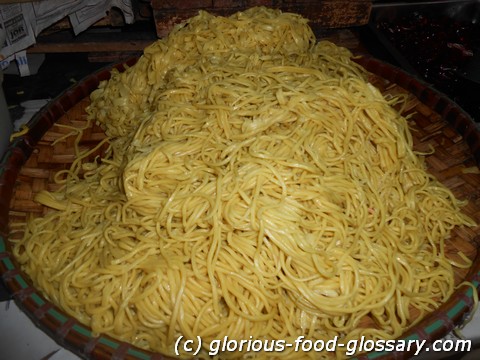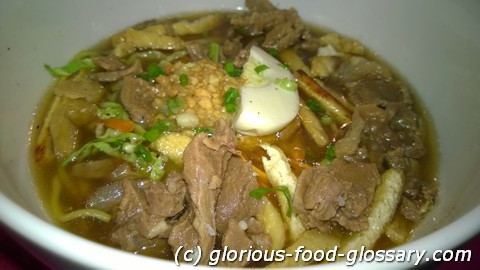Deutsch: Pancit Miki / Español: Pancit Miki / Português: Pancit Miki / Français: Pancit Miki / Italiano: Pancit Miki
Pancit Miki is another variant of the broad family of noodle dishes in Filipino cuisine, distinguished by its use of fresh, thick egg noodles known as Miki. Unlike Pancit Canton, which typically uses dried noodles, Pancit Miki's fresh noodles lend a distinctive chewy texture to the dish. This dish is often stir-fried with a variety of meats, such as chicken, pork, or seafood, and mixed with an assortment of vegetables like cabbage, carrots, and sometimes mushrooms. The seasoning, similar to other pancit dishes, can include soy sauce, fish sauce, or oyster sauce, adjusted to the cook's taste preference.
Description
Pancit Miki is a testament to the adaptability and diversity of Filipino noodle dishes, showcasing the influence of Chinese cuisine melded with local flavors and preferences. The fresh egg noodles used in Pancit Miki absorb flavors well, making each bite rich and satisfying. The dish is not only a culinary delight but also a cultural symbol, often served during celebrations and family gatherings to represent good health and long life, echoing the symbolism of noodles in many Asian cultures. The versatility of Pancit Miki allows for a wide range of ingredients, making it a popular choice for both everyday meals and special occasions.
Application Areas
In the culinary landscape of the Philippines, Pancit Miki is widely enjoyed in homes, local eateries, and at street food stalls. Its preparation and ingredients can vary from one region to another, reflecting the local tastes and available produce. This dish is also a staple in Filipino-themed restaurants worldwide, introducing the global palate to the rich textures and flavors of Filipino noodle cuisine.
Well-Known Examples
The basic composition of Pancit Miki allows for numerous variations, adapted by different regions in the Philippines. Some variations include Pancit Miki Guisado, where the noodles are stir-fried with vegetables and meat in a slightly thicker sauce, and Pancit Miki-Bihon, a combination of thick egg noodles and thin rice noodles, offering a delightful contrast of textures.
Treatment and Risks
Pancit Miki is a hearty and balanced dish, with the fresh noodles providing a good source of energy. The inclusion of a variety of vegetables and protein makes it a nutritious meal option. However, as with many noodle dishes, it can be high in sodium and fat depending on the amount of oil and soy sauce used in preparation. Individuals with dietary restrictions or health concerns may need to moderate their consumption accordingly.
Recipes
Simple Pancit Miki Recipe:
Ingredients:
- 1 lb fresh Miki noodles
- 2 tablespoons cooking oil
- 4 cloves garlic, minced
- 1 onion, sliced
- 1/2 lb pork, sliced thinly
- 1/4 lb shrimp, peeled and deveined
- 2 carrots, julienned
- 1 cup cabbage, shredded
- 2 tablespoons soy sauce
- 1 tablespoon oyster sauce
- Salt and pepper to taste
- Green onions, for garnish
- Prepare the Miki noodles according to package instructions, ensuring they are not overcooked. Drain and set aside.
- In a large skillet or wok, heat oil over medium heat. Sauté garlic and onion until aromatic.
- Add the pork and cook until it starts to brown. Add the shrimp and cook until they turn pink.
- Toss in the carrots and cabbage, stir-frying until the vegetables are tender yet crisp.
- Add the noodles to the skillet, followed by soy sauce and oyster sauce. Gently mix to combine all the ingredients evenly. Season with salt and pepper.
- Cook for a few more minutes until the noodles are heated through and have absorbed the flavors.
- Serve hot, garnished with chopped green onions.
Similar Terms or Synonyms
Pancit, in the context of Filipino cuisine, refers to a variety of noodle dishes. Pancit Miki is just one of many, such as Pancit Canton, Pancit Bihon, and Pancit Palabok, each distinguished by the type of noodles and preparation method used.
Summary
Pancit Miki offers a delicious glimpse into the Filipino tradition of noodle dishes, characterized by its use of fresh egg noodles and a savory mix of meats and vegetables. It's a versatile dish that represents the cultural heritage and culinary creativity of the Philippines, enjoyed in countless variations across the country and beyond. Whether as a simple family meal or a festive gathering dish, Pancit Miki remains a beloved part of Filipino cuisine.
--


Related Articles to the term 'Pancit Miki' | |
| 'Pancit Canton' | ■■■■■■■■■■ |
| Pancit Canton is a traditional Filipino noodle dish that is both versatile and beloved across the Philippines. . . . Read More | |
| 'Pancit' | ■■■■■■■■ |
| Pancit is the Filipino generic term for \'noodles\'. There are various kinds of noodle dishes in the . . . Read More | |
| 'Lomi' | ■■■■■■■■ |
| Lomi also called Pancit, Lomi is one of the varieties of noodle dishes in the Philippines. Lomi is a . . . Read More | |
| 'Pancit Bihon' | ■■■■■■■■ |
| Pancit Bihon in the food context refers to a popular Filipino noodle dish made from bihon (thin rice . . . Read More | |
| 'Bihun Goreng' | ■■■■■■■ |
| Bihun Goreng refers to Indonesian \'Fried Rice Noodles\'. . . . . . . Read More | |
| 'German' | ■■■■■■ |
| In the food context, German cuisine features a range of hearty and savory dishes, often made with meat, . . . Read More | |
| 'Alimasag' | ■■■■■■ |
| In the food context, \'Alimasag\' is the Tagalog word for a blue \'crab\' spotted medium sized crab. . . . Read More | |
| 'Lumpiang Shanghai' | ■■■■■■ |
| Lumpiang Shanghai in the food context refers to a popular Filipino dish consisting of thin, spring roll . . . Read More | |
| 'Lumpiang Hubad' | ■■■■■■ |
| Lumpiang Hubad in the food context refers to a Filipino dish that translates to \'naked spring rolls.\' . . . Read More | |
| 'Chami' | ■■■■■ |
| Chami also called Pancit Chami refers to a Filipino variety of Pancit (noodle dish) which is similar . . . Read More | |
